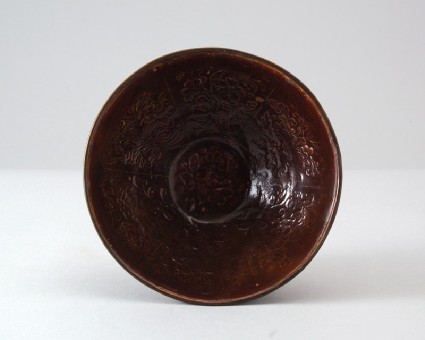The Barlow Collection
A select catalogue of the Barlow collection of Chinese Ceramics, Bronzes and Jades by the University of Sussex (published Sussex, 2006).

Publications online: 456 objects
Ding black ware bowl with seasonal flowers
- loan
-
Literature notes
Similar pieces have been attributed to the Ding kilns of Hebei, and a mould with a similar design is dated in accordance with 1206 (Zhongguo taoci quanji [Complete series on Chinese ceramics], vol.9, Shanghai, 2000, pl.130 top).
The piece is thinly potted and very light in weight, the conical sides somewhat convex, the rim slightly flared, the short foot with a low footring. The flat centre inside is impressed with a flower spray with two blooms and buds, the sides are divided in six panels by radiating raised lines, each moulded with a flower spray, showing lotus, herbacious peony, tree peony, pomegranate, chrysanthemum, and gardenia, each asymmetrically arranged and delicately rendered, with blooms, leaves and buds clearly depicted. An opaque brown glaze covers the piece inside and out, more thinly applied on and around the base. The rim is bound in copper. -
Details
- Associated place
-
Asia › China › Hebei province › Ding kilns (place of creation)
- Date
-
12th - 13th century (1101 - 1300)
Jin Dynasty (1115 - 1234)
- Material and technique
- stoneware, thrown, with moulded decoration under a brown iron glaze; glazed base; copper rim
- Dimensions
-
6.4 cm (height)
17 cm (diameter)
- Material index
- Technique index
- Object type index
- No. of items
- 1
- Credit line
- Lent by the Sir Alan Barlow Collection Trust.
- Accession no.
- LI1301.227
-
Further reading
University of Sussex, and Arts and Humanities Research Council, The Barlow Collection, supervised by Regina Krahl, Maurice Howard, and Aiden Leeves (Sussex: University of Sussex, 2006), no. C216
Glossary (3)
Ding, glaze, stoneware
-
Ding
A Chinese bronze tripod ritual cooking vessel. Also a type of white porcelain from Northern China.
-
glaze
Vitreous coating applied to the surface of a ceramic to make it impermeable or for decorative effect.
-
stoneware
Ceramic material made of clay which is fired to a temperature of c.1200-1300⁰c and is often buff or grey in colour.
Location
-
- currently in research collection
Objects are sometimes moved to a different location. Our object location data is usually updated on a monthly basis. Contact the Jameel Study Centre if you are planning to visit the museum to see a particular object on display, or would like to arrange an appointment to see an object in our reserve collections.
Publications online
-

The Barlow Collection
Similar pieces have been attributed to the Ding kilns of Hebei, and a mould with a similar design is dated in accordance with 1206 (Zhongguo taoci quanji [Complete series on Chinese ceramics], vol.9, Shanghai, 2000, pl.130 top).
The piece is thinly potted and very light in weight, the conical sides somewhat convex, the rim slightly flared, the short foot with a low footring. The flat centre inside is impressed with a flower spray with two blooms and buds, the sides are divided in six panels by radiating raised lines, each moulded with a flower spray, showing lotus, herbacious peony, tree peony, pomegranate, chrysanthemum, and gardenia, each asymmetrically arranged and delicately rendered, with blooms, leaves and buds clearly depicted. An opaque brown glaze covers the piece inside and out, more thinly applied on and around the base. The rim is bound in copper.
Notice
Object information may not accurately reflect the actual contents of the original publication, since our online objects contain current information held in our collections database. Click on 'buy this publication' to purchase printed versions of our online publications, where available, or contact the Jameel Study Centre to arrange access to books on our collections that are now out of print.
© 2013 University of Oxford - Ashmolean Museum



